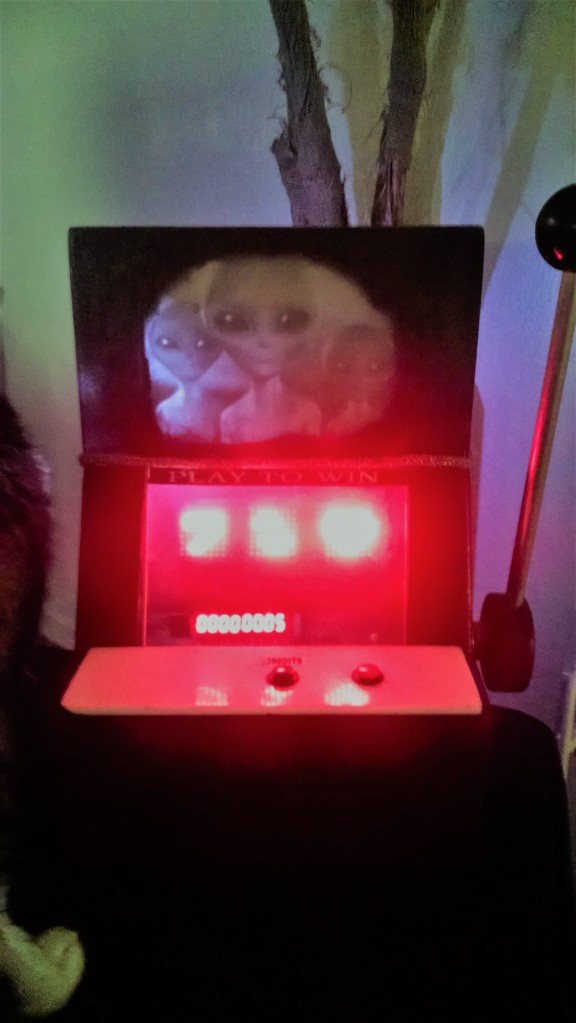
Sound and Voice Effects
Sound plays an important role in the user experience by adding another layer of depth; making for a more realistic experience. http://www.robotoid.com/sound/soundingoff-sounds.html
- Arduino and piezo ~ dual purpose can make sound or be used as a vibration sensor
- Low-cost option – WT588D ~ $5
- Other options include the Adafruit Audio sound board $20 and mini computer systems on a board, such as Raspberry Pi or similar $30+. These devices also need an SD card to provide memory space, more sensitive to vibrations and use more power.
SoundFX Lightshow
Using an Arduino Nano on an expansion board with push-buttons, one to play a sound and the other to select a sound effect from a WT588D through a speaker.
For this project, I’ve selected a low-cost option, internal memory, and reasonable sound quality – WT588D-U, this model includes a built-in mini USB port for power and direct programming. Sound output is amplified by the module and produced by a standard 0.5w 8-ohm speaker or can be connected to an amplified speaker system. The down-side with this module is that it can be difficult to get the programming software and drivers installed and configured.
Using the WT588D voice module connected to a basic speaker, the project can deliver cellular phone quality sound.
More information and tutorials specific to the WT588D:
- https://www.instructables.com/id/WT588D-Standalone-Arduino-sound-player/
- http://www.ars-informatica.ca/eclectic/programming-the-wt588d-sound-module-part-1/
- https://www.instructables.com/id/Getting-the-Most-Out-of-a-WT588D-Sound-Module/
There are several options for triggering a sound clip to play. Examining the documentation for this module including the schematic…The sound module has a few modes to select from when working with it. If there are only a few sounds that need to be triggered then the direct button mode would work without a microcontroller. However, if there are several sound clips, it takes just as many wires to connect to a microcontroller using the following 3-wire configuration:

I’ve taken the time to download sound clips, modify, and organize a few themes.
- Games – sound effects for the mechanics and the animation, GLaDoS voices from the Portal video game
- Spooky – selection of spooky sounds for Halloween projects.
- LCARS – Star Trek computer phrases and sounds.
- Zelda: Link To The Past – sounds from the video game.
Other themes online:

Parts:
- Arduino Nano
- Expansion Board
- USB to mini USB ~ 5ft. cord
- AC/DC Outlet Power Adapter
- Project Box
- WT588D Sound Module
- 8 x 7-segment Display module
- (1-4) strips of 10 RGB 12mm LEDs.
- (2) push-buttons
- photocell
- microphone
- PIR sensor
Steps:
Prepare the following for wiring and connect to the expansion board:
- WT588D with wiring harness and speaker
- (1-4) strips of 10 RGB 12mm LEDs.
- 8 x 7-segment Display Module
- (2) push-buttons
- photocell
- microphone
- PIR sensor
Connect the push-buttons to the expansion board and upload test code.

Connect strips of 10 RGB 12mm LEDs to the expansion board and upload test code.
Connect the 8×7 segment display module to the expansion board and upload test code.

 Connect the WT588D with wiring harness and speaker and upload test code.
Connect the WT588D with wiring harness and speaker and upload test code.
Any sensor can be used to trigger specific or random sounds and going even further, a basic neural network could make decisions using multiple sensor inputs.
Connect the photocell to the expansion board and upload test code.
Connect the Microphone to the expansion board and upload test code.
Connect the PIR sensor to the expansion board and upload test code.

Insert Arduino Nano into Expansion Board and plan to provide power using USB to mini USB cord. Optionally, AC/DC Outlet Power Adapter
Enclosing the project
Drill 7/16” – 1/2” holes into the project box:
- HOLE 1: side
- USB to mini USB ~ 5ft. cord
- Optionally, AC/DC Outlet Power Adapter
- HOLE 2: cover push-button
- HOLE 3: cover push-button
- top front side
- HOLE 4: (1-4) strips of 10 RGB 12mm LEDs
- HOLE 5: speaker connector
- HOLE 6: side
- microphone, PIR sensor
You can purchase a completed SoundFXLight directly from me as a functioning example.





Leave a comment